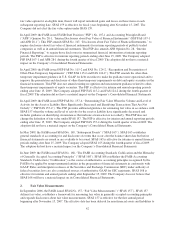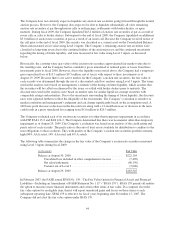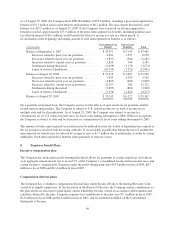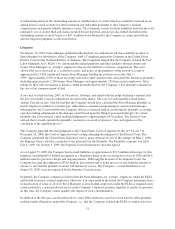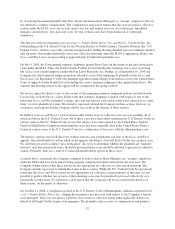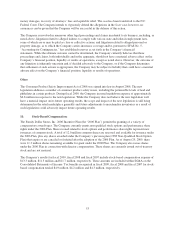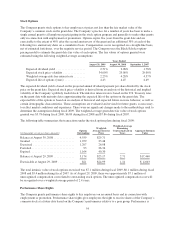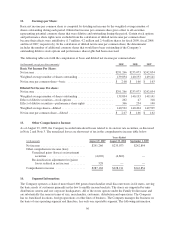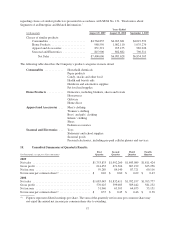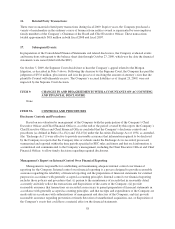Family Dollar 2009 Annual Report Download - page 59
Download and view the complete annual report
Please find page 59 of the 2009 Family Dollar annual report below. You can navigate through the pages in the report by either clicking on the pages listed below, or by using the keyword search tool below to find specific information within the annual report.A substantial portion of the outstanding amount of standby letters of credit (which are primarily renewed on an
annual basis) is used as surety for future premium and deductible payments to the Company’s workers’
compensation and general liability insurance carrier. The Company accrues for these liabilities based on the total
estimated costs of claims filed and claims incurred but not reported, and are not discounted. Included in the
outstanding amount of surety bonds is a $53.4 million bond obtained by the Company in connection with an
adverse litigation judgment, as discussed below.
Litigation
On January 30, 2001, Janice Morgan and Barbara Richardson, two individuals who have held the position of
Store Manager for subsidiaries of the Company, filed a Complaint against the Company in the United States
District Court for the Northern District of Alabama. The Complaint alleged that the Company violated the Fair
Labor Standards Act (“FLSA”) by classifying the named plaintiffs and other similarly situated current and
former Store Managers as “exempt” employees who are not entitled to overtime compensation. The court
allowed the case to proceed as a “collective action” and notice of the pendency of the lawsuit was sent to
approximately 13,000 current and former Store Managers holding the position on or after July 1,
1999. Approximately 2,550 of those receiving such notice filed consent forms and joined the lawsuit as plaintiffs,
including approximately 2,300 former Store Managers and approximately 250 then current employees. After
rulings by the Court on motions to dismiss certain plaintiffs filed by the Company, 1,424 plaintiffs remained in
the case at the commencement of trial.
A jury trial was held in June 2005, in Tuscaloosa, Alabama, and ended with the judge declaring a mistrial after
the jury was unable to reach a unanimous decision in the matter. The case was subsequently retried before
another Tuscaloosa jury, which found that the Company should have classified the Store Manager plaintiffs as
hourly employees entitled to overtime pay, rather than as salaried exempt managers, and awarded damages.
Subsequently, the Court ruled that the Company did not act in good faith in classifying the plaintiffs as exempt,
and after making adjustments to the damages award based upon the filing of personal bankruptcy by certain
plaintiffs, the Court entered a final modified judgment for approximately $35.6 million. The District Court
advised that it would consider the plaintiffs’ motion for an award of attorneys’ fees and expenses at the
conclusion of the appellate process.
The Company appealed this final judgment to the United States Court of Appeals for the 11th Circuit. On
December 16, 2008, the Court of Appeals issued a ruling affirming the judgment of the District Court. The
Company petitioned the United States Supreme Court to grant certiorari review of this ruling. On May 5, 2009,
the Supreme Court called for a response to the petition from the Plaintiffs. The Plaintiffs’ response was filed
July 6, 2009. On October 5, 2009, the Supreme Court decided not to hear the appeal.
As of August 29, 2009, the Company had accrued liabilities of approximately $51.6 million with respect to this
litigation, including $45.0 million recognized as a litigation charge in the second quarter of fiscal 2006 and $6.6
million related to previous charges and ongoing interest. Following the decision of the Supreme Court, the
Company has paid the judgment of $35.6 million, plus interest and is in the process of resolving the amount of
attorney’s fees that the plaintiffs Counsel will ultimately receive. The Company’s accrued liabilities as of
August 29, 2009, were not impacted by the Supreme Court decision.
In general, the Company continues to believe that the Store Managers are “exempt” employees under the FLSA
and should be paid as salaried employees. However, if at some point in the future the Company determines that a
reclassification of some or all of its Store Managers as non-exempt employees under the FLSA is required, such
action could have a material adverse effect on the Company’s financial position, liquidity or results of operation.
At this time, the Company cannot quantify the impact of such a determination.
In addition to the Morgan case described above, since 2004, numerous cases have been filed by other plaintiffs
making similar allegations against the Company, i.e., that the Company violated the FLSA or similar state laws
51



